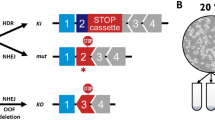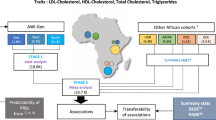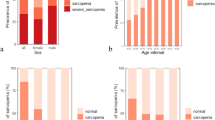Abstract
The scavenger receptor class B type 1 (SCARB1) gene is a key component in the reverse cholesterol transport pathway and thus plays an important role in lipid metabolism. Studies suggest that the SCARB1 gene may contribute to variation in plasma lipid levels at fasting; however, the results have been inconsistent, and it is unclear whether SCARB1 may also influence lipid response to dietary and pharmacologic interventions. In this study, we examined genetic variation in the SCARB1 gene in participants of the Genetics of Lipid Lowering Drugs and Diet Network (GOLDN) study for associations with basal lipid levels, changes in lipid measures after dietary fat intake, and fenofibrate treatment. We found that the exon 1 variant SCARB1_G2S was significantly associated with postfenofibrate change for triglycerides (TG) (P = 0.004). Subjects bearing SCARB1_G2S minor allele A tend to have higher responsiveness to fenofibrate in lowering TG. In summary, our study suggested that the SCARB1 gene may serve as a useful marker that predicts variation in baseline lipid levels, postprandial lipid response, and response to fenofibrate intervention.
Similar content being viewed by others
Log in or create a free account to read this content
Gain free access to this article, as well as selected content from this journal and more on nature.com
or
References
Abecasis GR, Wigginton JE (2005) Handling marker-marker linkage disequilibrium: pedigree analysis with clustered markers. Am J Hum Genet 77(5):754–767
Abecasis GR, Cherny SS, Cookson WO, Cardon LR (2001) GRR: graphical representation of relationship errors. Bioinformatics 17(8):742–743
Abecasis GR, Cherny SS, Cookson WO, Cardon LR (2002) Merlin-rapid analysis of dense genetic maps using sparse gene flow trees. Nat Genet 30(1):97–101
Acton S, Rigotti A, Landschulz KT, Xu S, Hobbs HH, Krieger M (1996) Identification of scavenger receptor SR-BI as a high density lipoprotein receptor. Science 271(5248):518–520
Acton S, Osgood D, Donoghue M, Corella D, Pocovi M, Cenarro A, Mozas P, Keilty J, Squazzo S, Woolf EA, Ordovas JM (1999) Association of polymorphisms at the SR-BI gene locus with plasma lipid levels and body mass index in a white population. Arterioscler Thromb Vasc Biol 19(7):1734–1743
Barrett JC, Fry B, Maller J, Daly MJ (2005) Haploview: analysis and visualization of LD and haplotype maps. Bioinformatics 21(2):263–265
Bietrix F, Yan D, Nauze M, Rolland C, Bertrand-Michel J, Coméra C, Schaak S, Barbaras R, Groen AK, Perret B, Tercé F, Collet X (2006) Accelerated lipid absorption in mice overexpressing intestinal SR-BI. J Biol Chem 281(11):7214–7219
Boehnke M (1991) Allele frequency estimation from data on relatives. Am J Hum Genet 48(1):22–25
Brown MS, Goldstein JL (1986) A receptor-mediated pathway for cholesterol homeostasis. Science 232(4746):34–47
Cullen P, Funke H, Schulte H, Assmann G (1997) Lipoproteins and cardiovascular risk-from genetics to CHD prevention. J Atheroscler Thromb 4(2):51–58
Durstine JL, Grandjean PW, Davis PG, Ferguson MA, Alderson NL, DuBose KD (2001) Blood lipid and lipoprotein adaptations to exercise: a quantitative analysis. Sports Med 31(15):1033–1062
Feitosa MF, Rice T, Rankinen T, Province MA, Chagnon YC, Gagnon J, Leon AS, Skinner JS, Wilmore JH, Després JP, Bouchard C, Rao DC, Borecki IB (2005) Evidence of QTLs on chromosomes 13q and 14q for triglycerides before and after 20 weeks of exercise training: the HERITAGE Family Study. Atherosclerosis 182(2):349–360
Fisher RA (1934) Statistical methods for research workers. Oliver and Boyd, Edinburgh
Gordon DJ, Rifkind BM (1989) High-density lipoprotein–the clinical implications of recent studies. N Engl J Med 321(19):1311–1316
Hauser H, Dyer JH, Nandy A, Vega MA, Werder M, Bieliauskaite E, Weber FE, Compassi S, Gemperli A, Boffelli D, Wehrli E, Schulthess G, Phillips MC (1998) Identification of a receptor mediating absorption of dietary cholesterol in the intestine. Biochemistry 37(51):17843–17850
Kozarsky KF, Donahee MH, Rigotti A, Iqbal SN, Edelman ER, Krieger M (1997) Overexpression of the HDL receptor SR-BI alters plasma HDL and bile cholesterol levels. Nature 387(6631):414–417
Kuller LH, Simkin-Silverman LR, Wing RR, Meilahn EN, Ives DG (2001) Women’s healthy lifestyle project: a randomized clinical trial: results at 54 months. Circulation 103(1):32–37
Lewontin RC (1964) The interaction of selection and linkage. II. optimum models. Genetics 50:757–782
Mero N, Van Tol A, Scheek LM, Van Gent T, Labeur C, Rosseneu M, Taskinen MR (1998) Decreased postprandial high density lipoprotein cholesterol and apolipoproteins A-I and E in normolipidemic smoking men: relations with lipid transfer proteins and LCAT activities. J Lipid Res 39(7):1493–1502
Ordovas JM (2001) Genetics, postprandial lipemia and obesity. Nutr Metab Cardiovasc Dis 11(2):118–133
Ordovas JM, Cupples LA, Corella D, Otvos JD, Osgood D, Martinez A, Lahoz C, Coltell O, Wilson PW, Schaefer EJ (2000) Association of cholesteryl ester transfer protein-TaqIB polymorphism with variations in lipoprotein subclasses and coronary heart disease risk: the Framingham study. Arterioscler Thromb Vasc Biol 20(5):1323–1329
Osgood D, Corella D, Demissie S, Cupples LA, Wilson PW, Meigs JB, Schaefer EJ, Coltell O, Ordovas JM (2003) Genetic variation at the scavenger receptor class B type I gene locus determines plasma lipoprotein concentrations and particle size and interacts with type 2 diabetes: the Framingham study. J Clin Endocrinol Metab 88(6):2869–2879
Otvos JD, Jeyarajah EJ, Bennett DW, Krauss RM (1992) Development of a proton nuclear magnetic resonance spectroscopic method for determining plasma lipoprotein concentrations and subspecies distributions from a single, rapid measurement. Clin Chem 38(9):1632–1638
Pankow JS, Province MA, Hunt SC, Arnett DK (2002) Regarding “Testing for population subdivision and association in four case-control studies”. Am J Hum Genet 71(6):1478–1480
Pérez-Martínez P, Ordovás JM, López-Miranda J, Gómez P, Marín C, Moreno J, Fuentes F, Fernández de la Puebla RA, Pérez-Jiménez F (2003) Polymorphism exon 1 variant at the locus of the scavenger receptor class B type I gene: influence on plasma LDL cholesterol in healthy subjects during the consumption of diets with different fat contents. Am J Clin Nutr 77(4):809–813
Rigotti A, Trigatti BL, Penman M, Rayburn H, Herz J, Krieger M (1997) A targeted mutation in the murine gene encoding the high density lipoprotein (HDL) receptor scavenger receptor class B type I reveals its key role in HDL metabolism. Proc Natl Acad Sci USA 94(23):12610–12615
Stangl H, Cao G, Wyne KL, Hobbs HH (1998) Scavenger receptor, class B, type I-dependent stimulation of cholesterol esterification by high density lipoproteins, low density lipoproteins, and nonlipoprotein cholesterol. J Biol Chem 273(47):31002–31008
Suter PM, Gerritsen-Zehnder M, Häsler E, Gürtler M, Vetter W, Hänseler E (2001) Effect of alcohol on postprandial lipemia with and without preprandial exercise. J Am Coll Nutr 20(1):58–64
Tsai MY, Yuan J, Hunninghake DB (1992) Effect of gemfibrozil on composition of lipoproteins and distribution of LDL subspecies. Atherosclerosis 95(1):35–42
Ueda Y, Royer L, Gong E, Zhang J, Cooper PN, Francone O, Rubin EM (1999) Lower plasma levels and accelerated clearance of high density lipoprotein (HDL) and non-HDL cholesterol in scavenger receptor class B type I transgenic mice. J Biol Chem 274(11):7165–7171
Uiterwaal CS, Grobbee DE, Witteman JC, van Stiphout WA, Krauss XH, Havekes LM, de Bruijn AM, van Tol A, Hofman A (1994) Postprandial triglyceride response in young adult men and familial risk for coronary atherosclerosis. Ann Intern Med 121(8):576–583
Wang N, Arai T, Ji Y, Rinninger F, Tall AR (1998) Liver-specific overexpression of scavenger receptor BI decreases levels of very low density lipoprotein ApoB, low density lipoprotein ApoB, and high density lipoprotein in transgenic mice. J Biol Chem 273(49):32920–32926
Yuan J, Tsai MY, Hunninghake DB (1994) Changes in composition and distribution of LDL subspecies in hypertriglyceridemic and hypercholesterolemic patients during gemfibrozil therapy. Atherosclerosis 110(1):1–11
Acknowledgments
We thank the families for their participation in this research. This work was supported by the National Institute of Health Heart, Lung, and Blood Institute grant U 01 HL72524, genetic and environmental determinants of triglycerides. We acknowledge Abbott Laboratories (Abbott Park, IL, USA) for their supply of study medication for this project. Dr. David B. Allison is supported by NIH grant 3P30DK056336. Dr. Kui Zhang is supported by NIH grant R01GM74913.
Conflict of interest
We declare that we have no duality or conflict of interest.
Author information
Authors and Affiliations
Corresponding author
Electronic supplementary material
Below is the link to the electronic supplementary material.
Rights and permissions
About this article
Cite this article
Liu, Y., Ordovas, J.M., Gao, G. et al. The SCARB1 gene is associated with lipid response to dietary and pharmacological interventions. J Hum Genet 53, 709–717 (2008). https://doi.org/10.1007/s10038-008-0302-2
Received:
Accepted:
Published:
Issue date:
DOI: https://doi.org/10.1007/s10038-008-0302-2
Keywords
This article is cited by
-
Influence of the rs4238001 Genetic Polymorphism of the SR-B1 Gene on Serum Lipid Levels and Response to Rosuvastatin in Myocardial Infarction Iraqi Patients
Biochemical Genetics (2023)
-
An Amish founder population reveals rare-population genetic determinants of the human lipidome
Communications Biology (2022)
-
Transcriptional shifts account for divergent resource allocation in feed efficient broiler chickens
Scientific Reports (2018)
-
The PPAR alpha gene is associated with triglyceride, low-density cholesterol and inflammation marker response to fenofibrate intervention: the GOLDN study
The Pharmacogenomics Journal (2013)
-
Profile of Serum Bile Acids in Noncholestatic Volunteers: Gender-Related Differences in Response to Fenofibrate
Clinical Pharmacology & Therapeutics (2011)



